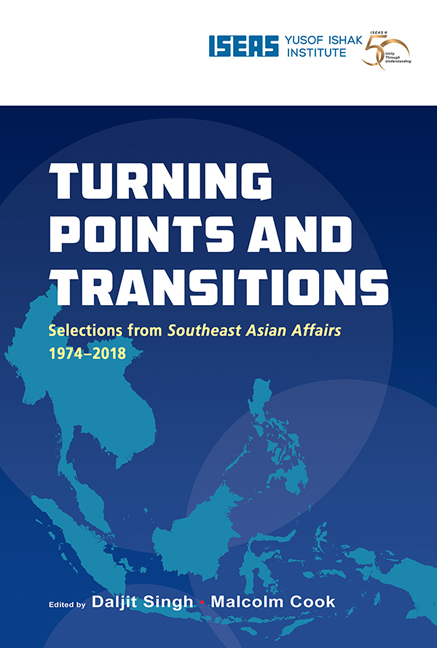Book contents
- Frontmatter
- Contents
- Message from the Director
- Foreword
- Foreword
- Introduction
- THE REGION
- The Diplomatic Emergence of China and Its Implications for Southeast Asia (1975*)
- Stability and Security in the Region after ANZUK (1975)
- The Question of the “Overseas Chinese” (1976)
- Southeast Asia 1976: The Handling of Contradictions (1977)
- The “Fukuda Doctrine” and Its Implications for Southeast Asia (1978)
- Expanding Horizons in Southeast Asia? (1994)
- AFTA in the Light of New Economic Developments (1995)
- The ASEAN Economic Miracle Unravels (1999)
- Southeast Asia in 1999: A False Dawn? (2000)
- East Timor's Future: Southeast Asian or South Pacific? (2001)
- Southeast Asia in 2002: From Bali to Iraq — Co-operating for Security (2003)
- The Year in ASEAN: The Charter, Trade Agreements, and the Global Economic Crisis (2010)
- Seeking Stability in Turbulent Times: Southeast Asia's New Normal? (2015)
- China's Two Silk Roads Initiative: What It Means for Southeast Asia (2015)
- China's International Strategy and Its Implications for Southeast Asia (2016)
- BRUNEI
- CAMBODIA
- INDONESIA
- LAOS
- MALAYSIA
- MYANMAR
- THE PHILIPPINES
- SINGAPORE
- THAILAND
- VIETNAM
The Question of the “Overseas Chinese” (1976)
from THE REGION
Published online by Cambridge University Press: 29 May 2019
- Frontmatter
- Contents
- Message from the Director
- Foreword
- Foreword
- Introduction
- THE REGION
- The Diplomatic Emergence of China and Its Implications for Southeast Asia (1975*)
- Stability and Security in the Region after ANZUK (1975)
- The Question of the “Overseas Chinese” (1976)
- Southeast Asia 1976: The Handling of Contradictions (1977)
- The “Fukuda Doctrine” and Its Implications for Southeast Asia (1978)
- Expanding Horizons in Southeast Asia? (1994)
- AFTA in the Light of New Economic Developments (1995)
- The ASEAN Economic Miracle Unravels (1999)
- Southeast Asia in 1999: A False Dawn? (2000)
- East Timor's Future: Southeast Asian or South Pacific? (2001)
- Southeast Asia in 2002: From Bali to Iraq — Co-operating for Security (2003)
- The Year in ASEAN: The Charter, Trade Agreements, and the Global Economic Crisis (2010)
- Seeking Stability in Turbulent Times: Southeast Asia's New Normal? (2015)
- China's Two Silk Roads Initiative: What It Means for Southeast Asia (2015)
- China's International Strategy and Its Implications for Southeast Asia (2016)
- BRUNEI
- CAMBODIA
- INDONESIA
- LAOS
- MALAYSIA
- MYANMAR
- THE PHILIPPINES
- SINGAPORE
- THAILAND
- VIETNAM
Summary
During the years which saw maximum Chinese withdrawal from international affairs together with maximum United States military commitment to Southeast Asia, the years 1965–71, there was very little journalistic or scholarly interest in the Chinese communities living in Southeast Asia. It was not until after June 1971, when President Nixon announced that he was going to visit Peking, that anxious questions once more began to be regularly asked about the future role of the “Overseas Chinese”. All the fears of the 1950s concerning these Chinese were quickly revived and a large variety of questions were asked. Most of them centred on two related problems with wide ramifications. Firstly, will the Chinese in Southeast Asia be the targets of subversion? Secondly, will they be encouraged to resist assimilation and reassert their Chineseness?
On both these, opinions were divided. There were many who felt strongly that the diplomatic reemergence of China necessarily meant trouble for Southeast Asian countries with Chinese minorities, although some concentrated more on the consequences of American military withdrawal than on what the Chinese planned to do. Others were confident that the time for such fears was over. Most of the Chinese had settled down and made their peace with the new nationalist governments that had emerged since 1945. Most of them were economically well-off and too committed to the more or less laissez faire economics of the region to want to destroy them. Where there was danger, it would come from the growing discontent among the indigenous poor and the political awakening of the indigenous young. Thus one view concentrates on the intentions of China and the other on the effectiveness of Southeast Asian governments. There should also be a third which looks more closely at the reactions of the local Chinese. Although no great threat need be expected from them, there will be changes among them in some specific ways, for example, regarding citizenship among those who have been nationals of the Republic of China in Taiwan and regarding the new perspectives on issues of loyalty and assimilation. These changes will depend on the current policies of Southeast Asian governments, the numbers of Chinese and the degree of assimilation already achieved in each country, and not least on the attitudes of individual Chinese about their countries of adoption.
- Type
- Chapter
- Information
- Turning Points and TransitionsSelections from Southeast Asian Affairs 1974-2018, pp. 20 - 31Publisher: ISEAS–Yusof Ishak InstitutePrint publication year: 2018



